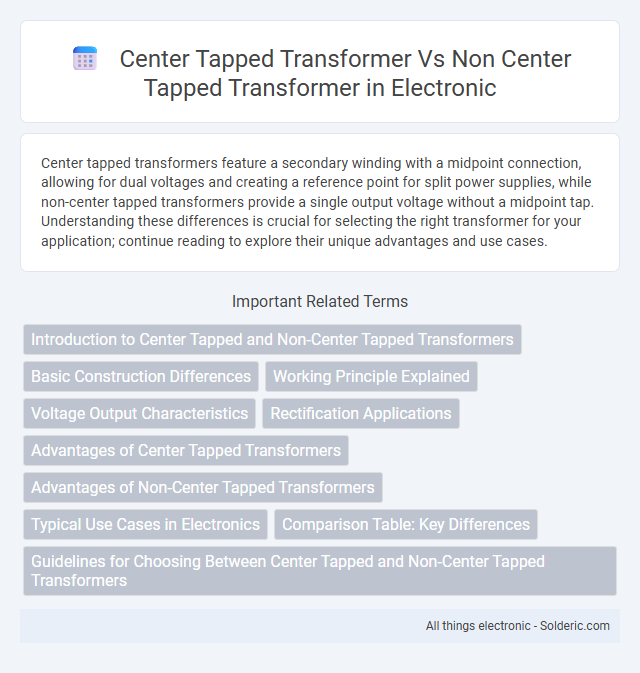Center tapped transformers feature a secondary winding with a midpoint connection, allowing for dual voltages and creating a reference point for split power supplies, while non-center tapped transformers provide a single output voltage without a midpoint tap. Understanding these differences is crucial for selecting the right transformer for your application; continue reading to explore their unique advantages and use cases.
Comparison Table
| Feature | Center Tapped Transformer | Non Center Tapped Transformer |
|---|---|---|
| Secondary Winding | Has a center tap dividing winding into two equal halves | Single continuous winding without center tap |
| Output Voltage | Two voltages available with reference to center tap (usually ground) | Single voltage output between winding ends |
| Usage | Common in full-wave rectifiers, split power supplies | Used in half-wave rectifiers and applications requiring single polarity voltage |
| Cost and Complexity | More complex and expensive due to center tap | Simple and usually cheaper |
| Rectifier Configuration | Allows full-wave rectification with two diodes | Requires bridge rectifier for full-wave rectification |
| Voltage Regulation | Better voltage symmetry and regulation | Less symmetrical voltage output |
Introduction to Center Tapped and Non-Center Tapped Transformers
Center tapped transformers feature a secondary winding with a central tap that creates two equal voltage outputs with opposite polarity, widely used in full-wave rectifiers and dual voltage power supplies. Non-center tapped transformers have a single secondary winding without a midpoint, providing a single voltage output ideal for simpler or cost-effective applications. The choice between these transformers depends on the required voltage configuration and circuit design complexity.
Basic Construction Differences
Center tapped transformers feature a secondary winding with a midpoint connection providing two equal voltages relative to the center tap, while non-center tapped transformers have a single continuous secondary winding without this midpoint. The center tap in these transformers enables split voltage outputs useful for dual polarity power supplies, whereas non-center tapped transformers deliver a single output voltage. Your choice depends on the required voltage configuration and application needs.
Working Principle Explained
A center tapped transformer features a secondary winding with a midpoint connection, creating two equal voltages that are 180 degrees out of phase, enabling full-wave rectification using two diodes in power supplies. In contrast, a non-center tapped transformer uses a single continuous secondary winding, providing only one output voltage and requiring a different rectification approach, typically a bridge rectifier. Understanding your circuit's needs is essential, as center tapped transformers simplify full-wave rectification but may require more complex wiring compared to non-center tapped transformers.
Voltage Output Characteristics
Center tapped transformers provide two equal voltage outputs from the secondary winding, producing dual voltage levels referenced to the center tap, which acts as a neutral point. Non center tapped transformers deliver a single voltage output across the entire secondary winding without a neutral reference, offering a simpler voltage waveform. The voltage output of center tapped transformers is suitable for creating dual-polarity power supplies, while non center tapped transformers typically supply single polarity voltage.
Rectification Applications
Center tapped transformers enable full-wave rectification using two diodes, providing smoother DC output with less ripple, making them ideal for low-voltage power supplies. Non-center tapped transformers require a bridge rectifier with four diodes to achieve full-wave rectification, which is beneficial when a center tap is unavailable or impractical. Your choice depends on circuit complexity, cost, and desired output quality for rectification applications.
Advantages of Center Tapped Transformers
Center tapped transformers provide the advantage of producing dual voltages from a single winding, enabling more versatile circuit designs such as full-wave rectification with fewer diodes. They improve efficiency by reducing ripple voltage in power supplies, which enhances the stability of Your electronic devices. This configuration simplifies grounding and allows for symmetrical power delivery, making center tapped transformers ideal for applications requiring balanced loads.
Advantages of Non-Center Tapped Transformers
Non-center tapped transformers simplify circuit design by reducing the number of required components, leading to lower manufacturing costs and increased reliability. They offer easier integration with full-wave rectifier circuits, enabling efficient power conversion with fewer diodes compared to center-tapped configurations. Your choice of a non-center tapped transformer often results in better space utilization and streamlined assembly in compact electronic devices.
Typical Use Cases in Electronics
Center tapped transformers are commonly used in power supply circuits requiring dual voltage outputs or full-wave rectification, enabling efficient conversion and smoother DC voltage for audio amplifiers and battery chargers. Non center tapped transformers are typically employed in simpler applications like step-up or step-down voltage conversion where a single secondary voltage is sufficient, such as in signal isolation and low-power devices. Your choice between these transformer types depends on the specific voltage and rectification needs in your electronic design.
Comparison Table: Key Differences
A center tapped transformer features a secondary winding with a central connection that provides two equal voltages with opposite polarity, ideal for full-wave rectification, while a non-center tapped transformer has only two output terminals with a single voltage output. Center tapped transformers are commonly used in applications requiring dual voltage supplies or balanced signals, whereas non-center tapped transformers are simpler and more cost-effective for standard voltage step-up or step-down needs. Key differences include the number of secondary terminals, output voltage configuration, complexity, and suitability for specific rectifier circuits.
Guidelines for Choosing Between Center Tapped and Non-Center Tapped Transformers
Choosing between center tapped and non-center tapped transformers depends on your application's voltage and current requirements. Center tapped transformers are ideal for full-wave rectification and dual voltage outputs, offering balanced voltages with a common ground reference. Non-center tapped transformers suit simpler, single voltage applications where a straightforward stepping up or down of voltage is needed without the complexity of dual outputs.
center tapped transformer vs non center tapped transformer Infographic

 solderic.com
solderic.com